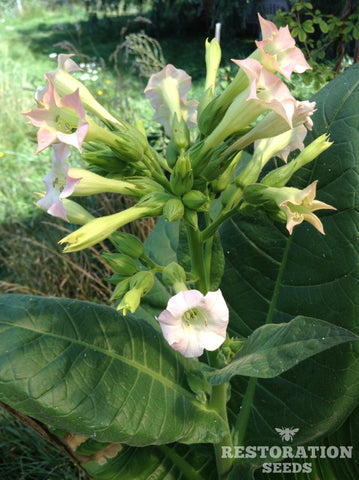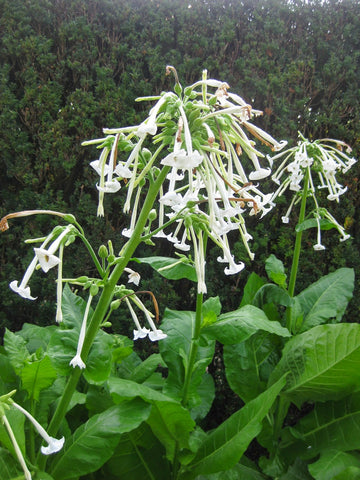SEED CALCULATOR ❌
Number of Plants 0
Weight 0 oz
at 0 seeds per foot

Tobacco
Certification
Heritage
Season
Semah, or tobacco, is one of the four traditional sacred plants. It represents the Eastern Direction and the mind. The Anishinaabe use a form of tobacco known as kinikinik, or a red willow mix. Because it opens the door to the creator, When tobacco is used to make smoke, it is one of the most sacred of plants for Native people. Some elders say that tobacco is used to connect the worlds since the plant’s roots go deep into the earth, and its smoke rises high into the sky. This plant is highly respected and highly honored. Giving tobacco is a beautiful way of our people. Ceremonies using tobacco invoke a relationship with the energies of the universe, and ultimately the Creator, and the bond made between earthly and spiritual realms is not to be broken. There are four traditional Tobacco uses, prayer, offerings, purification and respect.
Tobacco had already long been used in the Americas, with some cultivation sites in Mexico dating back to 1400–1000 B.C. Many Native American tribes traditionally grew and used tobacco as an entheogen. Eastern North American tribes carried tobacco in pouches as a readily accepted trade item, and often smoked it in peace pipes, either in defined sacred ceremonies, or to seal a bargain. They smoked it at such occasions in all stages of life, even in childhood. They believed that tobacco is a gift from the Creator, and that the exhaled tobacco smoke carries one's thoughts and prayers to the Creator. The English word tobacco originates from the Spanish and Portuguese word tabaco.<br><br>The four sacred plants are gift of the Four Manido, Spirits of the Four Directions. To those who live in the traditional way, there are four plants which are especially revered and used in daily living. The creator taught us to use the natural herbs of sage, sweetgrass, tobacco, and cedar smoke as a physical reminder to them of this omnipotent presence. It is the sacred way.

-
Price List
Semah, or tobacco, is one of the four traditional sacred plants. It represents the Eastern Direction and the mind. The Anishinaabe use a form of tobacco known as kinikinik, or a red willow mix. Because it opens the door to the creator, When tobacco is used to make smoke, it is one of the most sacred of plants for Native people. Some elders say that tobacco is used to connect the worlds since the plant’s roots go deep into the earth, and its smoke rises high into the sky. This plant is highly respected and highly honored. Giving tobacco is a beautiful way of our people. Ceremonies using tobacco invoke a relationship with the energies of the universe, and ultimately the Creator, and the bond made between earthly and spiritual realms is not to be broken. There are four traditional Tobacco uses, prayer, offerings, purification and respect.
Tobacco had already long been used in the Americas, with some cultivation sites in Mexico dating back to 1400–1000 B.C. Many Native American tribes traditionally grew and used tobacco as an entheogen. Eastern North American tribes carried tobacco in pouches as a readily accepted trade item, and often smoked it in peace pipes, either in defined sacred ceremonies, or to seal a bargain. They smoked it at such occasions in all stages of life, even in childhood. They believed that tobacco is a gift from the Creator, and that the exhaled tobacco smoke carries one's thoughts and prayers to the Creator. The English word tobacco originates from the Spanish and Portuguese word tabaco.<br><br>The four sacred plants are gift of the Four Manido, Spirits of the Four Directions. To those who live in the traditional way, there are four plants which are especially revered and used in daily living. The creator taught us to use the natural herbs of sage, sweetgrass, tobacco, and cedar smoke as a physical reminder to them of this omnipotent presence. It is the sacred way.


